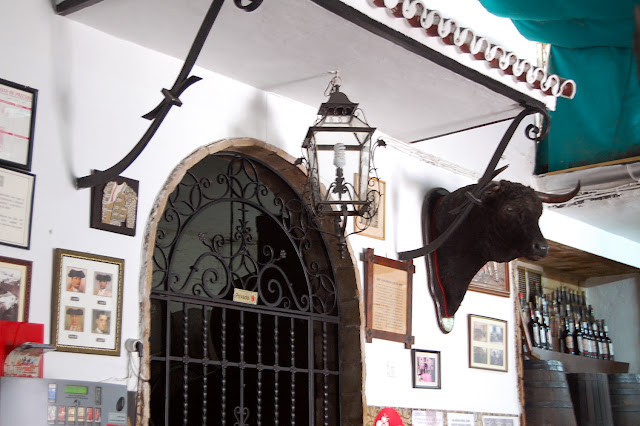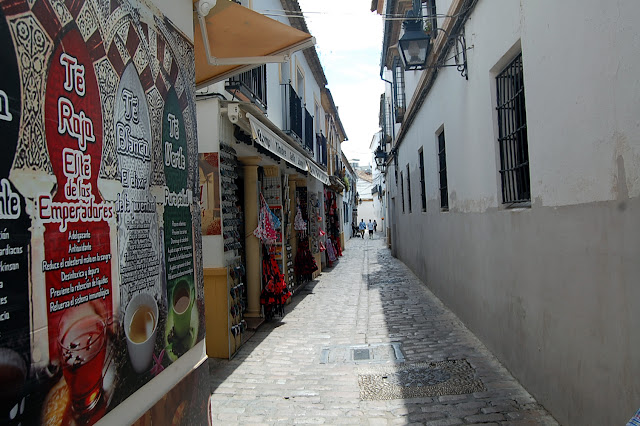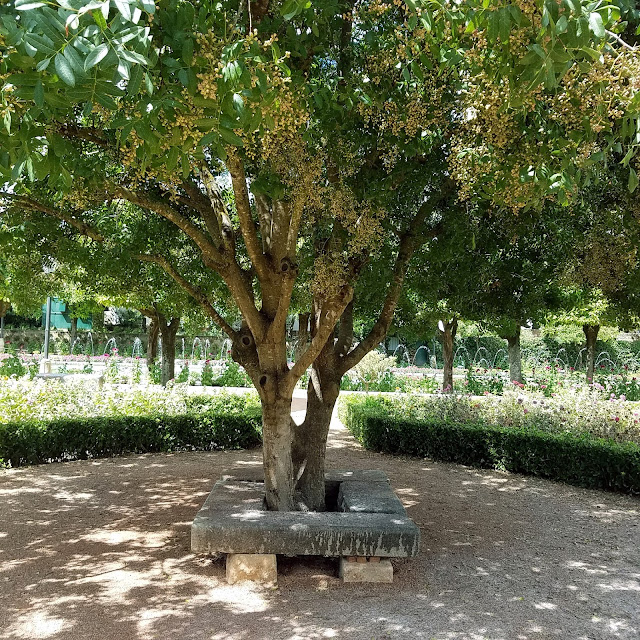Our wonderful trip was nearing its end as we left Cordoba and headed for Madrid. A morning bus ride took us to the town of Viso del Marques where we visited the Palace of the Marques de Santa Cruz built during the 1500's. The palace was yet another unexpected delight. As we walked towards the plain looking building shown in the first picture below I didn't know what to expect. There was no indication of its interior beauty.
As soon as we entered the interior courtyard we found an amazing sight! All around were painted alcoves depicting noteworthy historical sea battles.
Here are two examples of the paintings.
Elaborate stairways led to the upper floor.
Ceilings and walls on the upper floor were lavishly decorated with scenes of naval battles or mythology.
These ceilings were particularly bright and colorful.
The palace was home to Alvaro de Bazan (1526-1588), a Spanish admiral who was undefeated in naval battles during his entire career. He was also commander of the Spanish Armada, but died before the armada's demise. This statue of the admiral is located just outside the palace.
After the unexpected beauty of the admiral's palace we drove to a less exciting place. Our visit to the manchego cheese factory was, for me, the least favorite tour stop. We put on required paper robes, booties, and hair nets before entering the factory, as you can see below.
Manchego cheese is made from sheep's milk. Inside the factory the combination of nauseating smell and warm moist air made my stomach quake. We saw all the steps in cheese production as we walked from room to room and smell to smell. All the while I concentrated on not getting sick. Finally, we finished the factory tour and, thankfully, emerged into fresh air in a gift store/welcome center where samples of cheese were set out for us. Most of our group happily munched cheese, but not me! Genetic quirks have left my personal taste bud chemistry very sensitive to most cheese varieties. Cheeses enjoyed by lots of people taste like vomit to me. Manchego cheese falls into my vomit category, so I passed up the free samples. The factory manager then came out with gift bags containing huge wedges of the vile cheese. We politely declined the gifts, but he seemed personally insulted by our refusal and insisted we take the cheese. Later, we gave one gift bag to our bus driver and left the other in the refrigerator at our hotel.
My stomach recovered as we drove to a restaurant for lunch. These giant wine containers decorated the restaurant entrance.
The main course at lunch was sea bass served over a bed of baby eels. At first, the identity of the gray, noodle-like stuff under the fish was uncertain. Some of our group insisted it was noodles. Our guide remained uncharacteristically silent. I tentatively tried one "noodle". It had the taste and consistency of spaghetti and had no visible internal structure or eyes. Actually, it wasn't bad at all. It went well with the fish. I ate my entire serving. For once in my life I was more adventurous with food than C who wouldn't touch the stuff. Eventually, we discovered it was, indeed, baby eels as you can see in the picture below.
After lunch we drove to Madrid through La Mancha. Cesar, our guide, read a passage from Don Quixote, and we did see windmills, both modern and antique. Finally we arrived in Madrid and passed this enormous bull ring on the way to the hotel. The bull ring picture was taken from behind a bus window causing an unfortunate blue reflection.
Our hotel in Madrid was on the Calle de Goya, a very busy street. We were free for the evening to walk around and get dinner. People on the crowded streets looked determined to reach their destinations. It almost had the same feel as New York City. Gone was the more relaxed vibe of Seville. The Calle de Goya was lined with expensive stores. Many of the passing women looked like they stepped straight from the pages of a fashion magazine. Eventually, we found a small eating place on one of the side streets where we had sandwiches for dinner.
The next morning our bus drove around a little so we could see the general layout of sights in Madrid. Then we visited the Naval Museum where we saw a nice display of antique nautical instruments.
One of the highlights of the museum was a display of the original restored map of Juan de la Cosa who actually sailed with Colombus on voyages across the Atlantic. In 1500 Juan de la Cosa created the first map showing the Americas based on exploratory voyages of Columbus and others. Other museums may have copies of this map, but the Madrid Naval Museum has the real original map! The first picture below is the actual map. Unfortunately, the glass display case made it hard to photograph. The second picture below from the Internet isn't degraded by display case reflections. North is up, Europe and Africa are on the right, and the green eastern coasts of North America and Brazil are on the left. (Click on the second image for a larger view.)
Museum walls were covered with impressive paintings of naval battles like the three pictures below.
Several beautiful ship models were also on display.
After the Naval Museum we walked a short distance to the famous Prado Art Museum shown in the next picture.
Inside the Prado our local guide began lecturing at length about some of the paintings. Once again, my patience for these art lectures was quickly exhausted. In one room the guide went on and on about a "famous" portrait while my attention was drawn away to another more striking portrait that was, apparently, not famous enough for notice. I longed to spend more time looking for other remarkable art works instead of spending so much time on only the few deemed worthy by the guide. For example, the veiled sculpture below fascinated me. It is a bust of Queen Isabel II created in 1855 by Camillo Torreggiani. Isn't the effect just amazing? No pictures were allowed in the Prado, but I found the picture below on the Internet.
We next walked to another art museum, The Sofia Museum, where Picasso's Guernica was on display. It was nice to get free admission since we were "senior citizens". A variety of modern art was exhibited here, as well as several films about the Spanish Civil War, and some very old films from 1897. I particularly enjoyed these three paintings.
By the time we finished exploring the Sofia Museum we had been on our feet for most of the day. Nevertheless, we still needed to walk back to our hotel. We've been distance runners for most of our lives, so we are used to persevering through fatigue. I thought it would be nice to walk through a major city park on our route to the hotel. With the help of a map we found a route through the lovely Parque de El Retiro. On the way to the park we bought some ice cream and passed a row of stalls selling used books.
Attractive, shaded paths through the park were a welcome break from busy, traffic filled streets. Soon we came upon a lake in the heart of the park. Near the lake a man was feeding birds from his hand.
The lake was filled with people in row boats enjoying a glorious, sunny day.
Here is the scene as we neared the park exit.
We rested awhile back at our hotel before joining the tour group for a final dinner. The next morning we departed early for the Madrid airport.
We had a wonderful, wonderful trip! Places we saw in Portugal and Spain were lovely, historic, fascinating, and beautiful. Sunny mild weather throughout the tour helped present these modern countries in a good light. Food and lodging were consistently excellent. Our outstanding expert tour guide, Cesar, was efficient, friendly, patient, witty, and a font of historical knowledge. He was largely responsible for the success of the tour. I will retain fond memories of this trip for a long time to come.
















































































